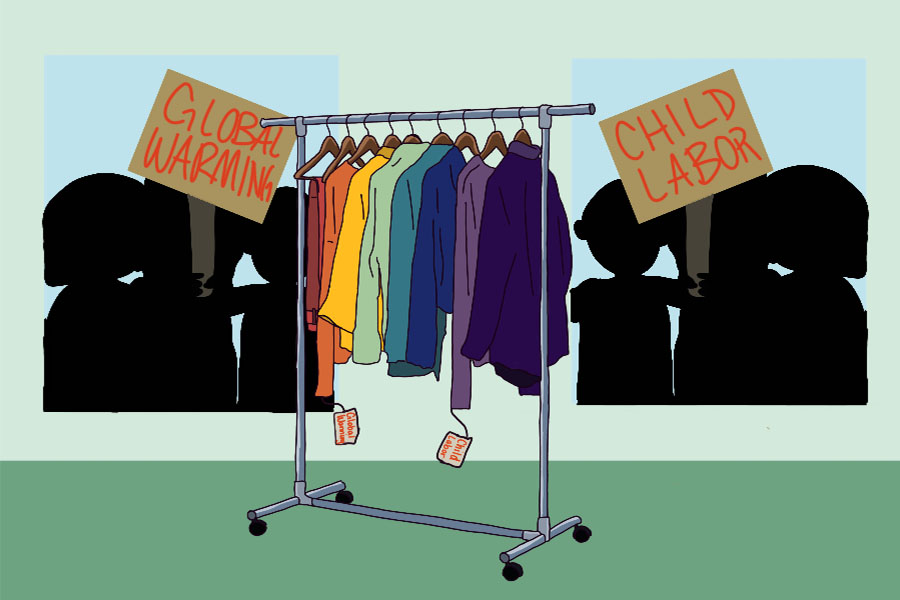Think again before purchasing that cheetah print skirt
In an ever growing market, the fashion industry chooses to prioritize sales over climate impact and the wellbeing of many child workers. The Sidekick staff writer Anjali Krishna discusses the ways in which fast fashion contributes to climate change and inhumane working conditions.
May 6, 2020
My mother likes to tell me that my toxic trait is thinking I have to buy a new outfit for every event. Maybe just this one time, I’ll have to admit she’s correct.
Clothes shopping used to be something done occasionally, when the weather changed or when our size did. Somewhat recently though, about 20 years ago, shopping took a turn. Clothes were no longer just a necessity but the activity of clothes shopping form of entertainment as clothes got cheaper and styles changed faster.
The emergence of the sewing machine had allowed the creation of mass clothing production in factories and combined with growing globalization placing these factories in developing nations, the idea for fast fashion emerged.
Suddenly, stores were selling trendy clothing you could buy with your piggy bank. Everyone could afford to dress like celebrities and everyone could wear the clothes they saw on the catwalk. It seemed too good to be true – and it was. This is the phenomenon called fast fashion, trendy clothing copied straight off the catwalk available to the general public at a dirt cheap price – with just a few catches.
The pressure to reduce prices and production times means that the factories producing fast fashion have to cut corners, often where it concerns human labor and the environment.
As of today, the apparel industry is the second largest polluter of clean water thanks to toxic textile dyes, only falling after agriculture. Majority of textiles, more than 60% are now synthetics derived from fossil fuels.
Polyester, one of the most popular textiles, sheds fibers adding to the growing amount of plastics in the oceans and cotton, a natural textile at the large scale of global warming, requires excessive water and pesticides from the developing countries it is produced in, often leading to stress on water basins and soil.
The textiles are not only one of the leading causes of global warming, but their cheap price means they are also of low quality. Fast fashion wears out quickly, and a consumer who has purchased a product of fast fashion is forced to buy something new. In designing their clothes with an expiration date, fast fashion sets themselves up for a cycle of continuous success.
Increasing the speed at which apparel is created also increases the speed at which garments are disposed of. In 2016, the average American threw away 81 pounds of clothing. When tossed, this clothing won’t just disappear. Rather, a garment of fast fashion will contribute to pollution throughout its entire lifetime, both in its toxic creation and its forever stay in a landfill.
It took the death of more than 1,000 workers in a Bangladeshi clothing manufacturing factory collapse and the injury of almost 6,000 more to bring fast fashion’s negative effects to the eye of the public. A shockwave rolled through the world as it was found that the factory’s collapse had killed mostly women and children who were overworked and underpaid in a building that did not comply with safety requirements.
The textile industry has historically relied on the exploitation of labor for its profit. Slave labor below the Mason-Dixon line famously provided workers for the Triangle Shirtwaist Factory, as well as for English factories best known for child labor and working condition horrors. The long-standing tradition continues today, even in a world after the Bangladeshi Dhaka factory’s collapse.
Immigrant workers in Los Angeles are paid as little as $2.77 hourly in comparison to the $12 minimum wage in California while making Fashion Nova products, and even this massive wage theft is no comparison for the inhumane working conditions of fast fashion laborers in developing nations.
But even through all of fast fashion’s crimes, it’s easy to see its temptation. Wearing the same outfit to multiple events is unappealing and on social media, it’s considered indecorous to post in the same outfit more than once which fuels the desire for constant wardrobe renewal. For high school students looking to get through graduation season or a sorority member in rush week, fast fashion seems like a win-win with both cheap prices and the most recent trends.
Environmental issues and unethical labor practices have been the norm in factories that create fast fashion since their very beginning. Considering the importance of price in purchase, what then, is the alternative for buying fast fashion?
Thrifting, for one, is anyone’s best shot at saving humanity while shopping. Point blank recycling, thrifting gives clothing a new life instead of a forever future in a landfill, thereby reducing new items being produced and the need for someone to produce them, and as mass production typically comes at the expense of human rights, using the clothes already existing in the world is a simple solution.
Follow Anjali (@anjalikrishna_) and @CHSCampusNews on Twitter.











